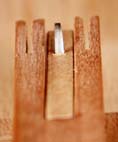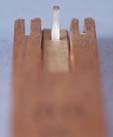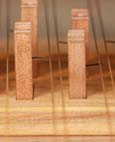|
The use of raven feathers for quills |
||
|
Click on these images for a larger image and for further details
Click on the images above for further information |
The instruments which we make can, on request, be voiced in natural raven's quill. Instrument number 1, the most elaborately made and decorated of the 4 Neapolitan instruments, has been quilled using natural bird quill. Raven, the traditional material for use as quill, is no longer a protected species in Canada. The numbers of ravens in the Province of Alberta, for example, have grown continuously since the time when they used to be protected, and ravens are now considered by many farmers, dairymen and cattle ranchers as a pest. This is because of the raven's habit of pecking out the eyes of newborn farm animals (they are also not much appreciated in Scotland for similar reasons! Needless to say there are numerous illegal raven and crow traps on most Highland estates). As I have a number of friends and relatives in Alberta, I have asked that the wings of any ravens that are destroyed by way of pest control are handed over to me. And being a keen Highland hillwalker I often come across wire-net raven and crow traps which are usually furnished with a good supply of fresh feathers - sometimes very fresh! The feathers that are of use to the harpsichord maker are the six wing primary flight feathers. Unfortunately none of the other wing feathers and not even the large tail features are sufficiently strong to be useful. Cutting the quills to length and regulating their strength so that the amount of energy given to the strings produces a uniform sound throughout the entire compass of the instrument is called voicing. This is a manual skill requiring dexterity, precision and patience. Normally the voicing of an instrument is a job left to the harpsichord builder, but a skilled amateur used to working with tools and their hands often become accomplished at voicing. Most modern harpsichord makers use a plastic substitute for natural raven quill. But whereas the modern plastic is completely uniform, the natural quill is much softer underneath the quill and there is an extremely hard, stiff, tough layer at the top. Because of its uniform property the modern plastic quill reacts the same no matter from which part of the quill the material is cut during voicing. However, being much softer underneath, more material can be removed at a time with natural quill without changing its stiffness markedly. The majority of the stiffness of the natural quill resides in the thin, hard top layer. Hence, in some ways, the voicing of natural quill is easier than voicing plastic quill since removing some of the soft material underneath the quill is a kind of fine tuning on the basic voicing process. This is because the different parts of the compass are voiced using different parts of the feather: the treble notes are voiced with the weaker end of the feather furthest from the bird, and the bass notes requiring stronger quills are voiced using the thicker, stiffer material from the base of the feather. Hence the middle of the feather is used for voicing the notes in the middle of the harpsichord compass. Thus the feather comes with a certain amount of in-built pre-voicing and normally requires only a small amount of additional cutting away underneath in order to provide an even, balanced sound across the whole of the compass. In practice, experience has shown that, as one is working one's way through the length of the feather after having voiced a given note, the best place to use the next bit of feather is in a jack a fourth lower than the jack just voiced. This means that as many as 10 quills can be obtained from one adult feather and that as few as 4 o 5 feathers are required for one register. Thus the six primary flight feathers provided by the wings of one bird should easily be enough to quill and voice one two-register harpsichord. The question then arises: "Is there a difference in the sound produced by bird quill from that produced by plectra made of plastic?". This is probably not easy to answer without a detailed scientific analysis of the sound using a careful spectral and power analysis. It is hard to see how there can be any difference if the amount of projection of the quill beyond the string is the same, and the amount that the string is lifted is the same. Hence if the vertical and horizontal components of the displacement of the string are the same in the two cases, how can the string tell whether its being plucked by natural quill or plastic? If there is a difference in the sound probably the only difference between the two materials is that the natural quill can be made much sharper at its end than plastic quills.
Go back to the main page of this section
|
|







